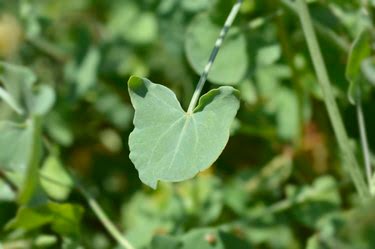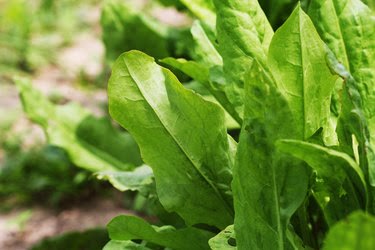Quck answer
French sorrel is a versatile and easy-to-grow herb that adds a tangy and lemony flavor to dishes. To grow French sorrel, start by choosing a location with well-draining soil and partial shade. Plant the seeds or seedlings in the spring or fall and keep the soil moist but not waterlogged. French sorrel can be harvested when the leaves are young and tender. It can be used in salads, soups, sauces, and as a garnish. With proper care and attention, you can enjoy a steady supply of fresh French sorrel throughout the growing season.
If you want to add a unique flavor to your salads, try growing zesty French sorrel (Rumex scutatus). This leafy green vegetable is not only easy to grow but also rich in potassium and vitamins A and C. If you live in USDA plant hardiness zones 5 through 9, you can grow French sorrel as a perennial plant.
French sorrel belongs to the buckwheat plant family (Polygonaceae), along with other types of sorrel. Rhubarb (Rheum x cultorum, zones 3-8) is also a member of this family. The two most commonly cultivated species in this genus are French sorrel and garden sorrel (Rumex acetosa, zones 3-7), also known as common sorrel. The main differences between these two species are their size and taste. French sorrel is shorter (6 to 12 inches) and less acidic, while garden sorrel is taller (18 to 24 inches) and has a stronger acidic taste.
Top Uses for French Sorrel
Fresh sorrel leaves have a lemony flavor that adds a tang to both fresh and cooked dishes. The flavor of mature leaves harvested later in the season is more pronounced compared to the new leaves harvested early in the season. Regardless of when you harvest, you will still experience the characteristic lemony flavor.
While it may not be ideal to make a salad solely with fresh sorrel due to its acidic taste, you can still use it as an accent among other leafy greens. The leaves contain a high level of oxalic acid, which can be harmful in large quantities as it inhibits the absorption of other nutrients like calcium. Individuals prone to kidney stones, arthritis, or rheumatism should exercise caution. To be safe, use fresh sorrel leaves as a complementary ingredient in your salads rather than as the main component.
If you prefer to reduce the oxalic acid content, you can cook the sorrel leaves. Enjoy a hot sorrel soup with crusty rolls on a cold winter’s day, sauté it with other vegetables and serve it over pasta or rice, or steam the leaves as you would do with other leafy greens. Keep in mind that sorrel leaves may cause discoloration in cooking utensils and serving dishes due to their high acid content.
French sorrel is a versatile plant that can be grown in various sunny spots in your garden, thanks to its compact size and mounded shape. It works well as both an edible crop and an ornamental plant. You can even use it as an edging plant to border your flower bed instead of confining it to the vegetable or herb garden. If you prefer container gardening, French sorrel can be mixed with other plants or grown as a standalone plant.
Growing French Sorrel: Step-by-Step Guide
Plant Profile: French Sorrel
- Common Name: French sorrel
- Botanical Name: Rumex scutatus
- When to Plant: Sow seeds in the beginning of spring or plant transplants in the early spring or fall
- USDA Zones: 5-9
- Sun Exposure: Full sun to partial shade
- Soil Type: Moist, fertile soil with high organic matter content
- When it’s in Trouble: French sorrel leaves may wilt on dry soil and plants may rot on soggy soil
- When it’s Thriving: Leaves are firm and green with no blemishes when grown in full sun on moist, well-drained soil
Starting French Sorrel From Seed
To start growing French sorrel from seeds, begin by sowing the seeds indoors about three weeks before the last frost in your area. Alternatively, you can directly sow the seeds into your garden in early spring. Here’s how to plant French sorrel seeds:
- Sow the seeds 1 inch deep in a soilless seed-starting mix that contains ingredients like coir, vermiculite, or perlite. Keep the mix moist but not wet until the seeds germinate.
- Place the seed-starting tray or individual pots in a location with bright light, preferably in front of a sunny window.
You can start harvesting the young leaves approximately 60 days after spring sowing. If you leave the seed stalks on the plants, the French sorrel may self-seed. Thin the seedlings to prevent overcrowding, which can hinder their growth. Overcrowded plants also have reduced air circulation, which can keep the leaves damp and make them susceptible to diseases.
Starting French Sorrel From Seedlings
Transplant the seedlings after the last frost date in spring, when there is no risk of freezing temperatures that could harm the delicate seedlings. When planting the transplants in the garden, space them at least 12 inches apart. Be careful not to plant the transplants any deeper than they were growing in their pots to avoid burying the crown, which can lead to rot. If you started French sorrel from seeds or if your plants self-sowed, thin the seedlings to the same distance apart.
Which USDA Zone is Best for Growing French Sorrel?

Image Credit:
Nahhan/iStock/GettyImages
French sorrel grows as a perennial in USDA plant hardiness zones 5 through 9, but gardeners in colder zones can grow it as an annual. Plants grown in warmer zones may bolt quicker, meaning they will produce flower stalks and seeds, which can cause a decline in leaf production. However, removing these flower spikes might allow the plants to continue producing leaves for harvest.
‘Profusion’ (Rumex scutatus ‘Profusion’) is a cultivar that does not produce seeds, therefore it does not bolt. It continuously produces lots of leaves throughout the season.
In cooler regions or areas within the French sorrel’s hardiness range, you may want to protect early transplants from frost damage by using floating row covers or other lightweight fabric. Uncover the plants in the morning when temperatures rise above freezing and cover them again before sundown.
What is the Best Time to Plant French Sorrel?
If you sow seeds or plant transplants in spring, you will have a longer growing season. However, you can also plant French sorrel at any time during the growing season. As long as it becomes established before the arrival of cool temperatures in autumn, especially around the first frost, French sorrel will survive the winter in its hardiness range. If your garden is outside this range, planting as early as possible will result in the most harvestable leaves during the growing season.
Soil, Sunlight, and Water Recommendations for French Sorrel
French sorrel can adapt to various types of soil, including sand, clay, and loam, as long as the soil has good drainage. The plant thrives in soil that is moist but not waterlogged. Aim for moist, well-draining soil that is rich in organic matter. Maintaining a soil pH between 5.5 and 6.8 will yield the best results.
Full sun is ideal for French sorrel, but it can also tolerate partial shade. If you don’t have a suitable sunny spot in your garden, you can grow French sorrel in a container on a sunny patio or deck.
To ensure a bountiful harvest of leaves, keep the soil moist so that French sorrel can continue to produce new leaves. Water the plants thoroughly, saturating the soil to a depth of at least 1 inch per week during the growing season. If you are growing French sorrel in containers, you will need to water more frequently as the soil in containers dries out faster than in-ground soil. Water container plants when the top 2 inches of soil are dry.
How to Propagate French Sorrel
In addition to growing French sorrel from seeds, you can also propagate new plants by dividing established ones. To do this, use a shovel or spading fork to lift out clumps of French sorrel. You can separate individual plants within each clump or slice through a single mound and divide it into sections.
If the divisions are large, you can replant them directly in the garden. For small divisions, it is recommended to pot them up and keep them moist in a semi-shady location until they are large enough to be transplanted into the garden.
You can divide French sorrel clumps at any time during the growing season, but dividing them in spring gives the plants the entire growing season to establish themselves before the arrival of cooler weather, making them more resilient to winter temperatures.
How to Protect French Sorrel in Winter
During winter, French sorrel usually dies back to the ground and re-emerges in spring, except in mild regions within its perennial range where leaves can be harvested year-round. To protect French sorrel from extreme winter temperatures, cover the plants with straw mulch or a mixture of straw and compost, especially in marginal areas within its hardiness zones. Rake back the mulch when the plant begins to emerge in spring.
How to Harvest French Sorrel

Image Credit: Vaivirga/iStock/GettyImages
In regions with mild winters, French sorrel leaves can be harvested throughout the cold season. However, in most climates, sorrel is only harvested during the warm growing season, from early spring until fall when frost kills the top growth. Harvest the green leaves by picking them individually.
The ideal time to freeze French sorrel leaves is when they are fresh. This way, you can store them for later use if you have a surplus from your harvest. Freezing them allows you to have a supply of leaves to add to your winter soups when French sorrel naturally dies back at the end of the growing season.
Common Issues and Pests Affecting French Sorrel
French sorrel is highly resistant to pests and diseases. While aphids may occasionally be a problem, you can easily control them without resorting to chemicals by simply spraying them off using a garden hose or water wand.
One specific issue with French sorrel is its toxicity to dogs, cats, and horses. Consuming a small amount of French sorrel may cause an upset stomach in animals. However, if an animal ingests large quantities of the leaves or repeatedly consumes them, it can lead to weakness, seizures, and kidney damage.
If you have pets that are prone to nibbling on your garden plants, it is advisable to create a wire barrier around your French sorrel plants. This barrier will allow sunlight and water to reach the plants while keeping your pets away.
Common Diseases Affecting French Sorrel
Fungal diseases, such as crown rot and root rot, are the main concerns when it comes to French sorrel. Thankfully, these diseases are generally preventable. To avoid crown rot, make sure to plant French sorrel with its central crown at or slightly above soil level. Additionally, ensure that the soil has good drainage to prevent root rot.
Consider planting French sorrel in raised beds if you have soil with poor drainage. When watering the plants, it is recommended to direct the water near the root zone rather than using overhead irrigation. This will prevent the leaves from staying wet and becoming a breeding ground for fungal pathogens.


